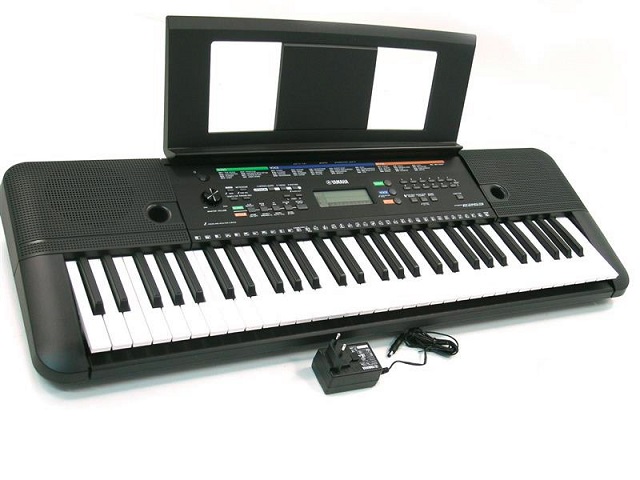 When I was told that I was to review another piano/keyboard, I was expecting a large, break-your-back, heavy digital piano to be dropped at my doorstep. The PSR-E253 is a 61-note keyboard that is packed with a lot of features. I quickly found out that this is definitely not your run-of-the-mill digital piano.
When I was told that I was to review another piano/keyboard, I was expecting a large, break-your-back, heavy digital piano to be dropped at my doorstep. The PSR-E253 is a 61-note keyboard that is packed with a lot of features. I quickly found out that this is definitely not your run-of-the-mill digital piano.
Overview of the PSR-E253
The PSR-E253 is fairly light for a keyboard—just under 4 kilograms (almost 9 pounds) and is 94 cm x 10.6 cm x 31.7 cm (H x W x D). The tone generation method used in the keyboard is Yamaha’s proprietary AWM (Advanced Wave Memory: essentially a sample play-back engine) and it offers up to 32 voices of polyphony.
There are over 372 loaded instrument “voices” along with 13 different drum and sound effects kits available. Yamaha has also supplied a few effects to apply to your performances: Reverb (9 types), Chorus (5 types), Ultra-Wide Stereo (3 types) and Master EQ (6 types).
There are 102 songs of various styles (along with 12 chord study lessons) to engage in Yamaha’s Education Suite (YES) curriculum.
On the face of the keyboard, there is an LCD display in the middle of all the buttons and knobs used to control the many functions available in the device. There are two 12 cm, 2.5W ported speakers mounted on the top of the keyboard.
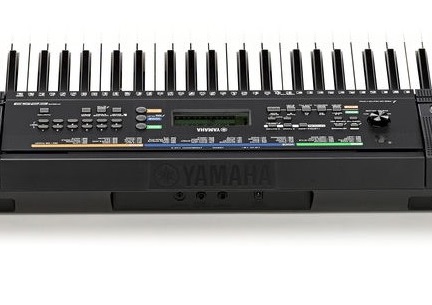 On the back of the keyboard, there are three ports (in addition to the AC-in port). The Aux-IN port accepts an ⅛” stereo jack so that you can plug in an external sound source, such as an MP3 player, to play along with. The ¼” stereo headphone port will allow you to listen to the PSR-E253 through any standard set of headphones. Finally, the ¼” sustain pedal port gives you the option to plug in any standard sustain pedal.
On the back of the keyboard, there are three ports (in addition to the AC-in port). The Aux-IN port accepts an ⅛” stereo jack so that you can plug in an external sound source, such as an MP3 player, to play along with. The ¼” stereo headphone port will allow you to listen to the PSR-E253 through any standard set of headphones. Finally, the ¼” sustain pedal port gives you the option to plug in any standard sustain pedal.
The PSR-E253 can be powered by six AA batteries or by the included 6W AC adapter. A detachable music rest is also included with the keyboard that can be mounted at the back of the unit, above the main display and controls.
In Use
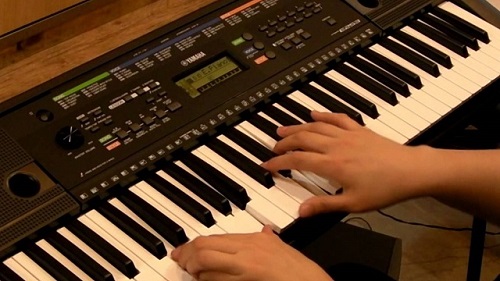 The PSR-E253 is competently aimed at the amateur, beginner and learning musician. It’s not to say that the PSR-E253 can’t be used in professional situations, but it’s really best suited for people who want to have fun making and learning music at their own pace and without all the traditional formality.
The PSR-E253 is competently aimed at the amateur, beginner and learning musician. It’s not to say that the PSR-E253 can’t be used in professional situations, but it’s really best suited for people who want to have fun making and learning music at their own pace and without all the traditional formality.
The keyboard action won’t impress seasoned musicians, but the full-size keys offer enough resistance and bounce-back to be satisfying. The layout of the controls above the keyboard weren’t entirely intuitive at first, but eventually made sense after reading through the manual. To be fair, there is a LOT of stuff that’s packed into this instrument and it must have been a challenge to layout the interface to service all the built in functions.
You’re not going to disturb your neighbours nor are you going to rattle the dishes with the on-board sound system. The built-in speakers are good and decent enough to clearly hear all the things going on in the keyboard.
The interesting stuff with this keyboard begins when you start exploring.
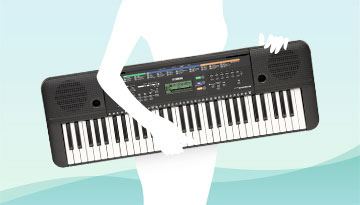 Trying out the instruments, drums and sound effects can take a while to get through. The patches (Yamaha names them “Voices”) are organized into groupings (piano, organ, guitar, drum kits, etc.) that are marked above the LCD panel.
Trying out the instruments, drums and sound effects can take a while to get through. The patches (Yamaha names them “Voices”) are organized into groupings (piano, organ, guitar, drum kits, etc.) that are marked above the LCD panel.
Styles and Lessons
For the beginner, the PSR-E253 comes into its own through the bells and whistles it packs in.
If you know a melody and the basic chords of a song, then through the Style function, you can pick a specific style and auto-accompaniment to play along with you. I had a bit of fun trying out hard rock tunes I knew with styles such as “Oberpolka”, “Christmas Swing” and “Foxtrot”.
If you’re an aspiring songwriter with limited technique on the keyboard, the Style function could really come in handy to help realize and flesh out your music.
The lessons on the PSR E253 aren’t going to get you through the Toronto Royal Conservatory exams, but that’s not the intent in their design. There are 100 songs programmed into the instrument that can be used as part of the Yamaha Education Suite (YES). After registering with Yamaha, you can download a PDF copy of the music for all the included songs.
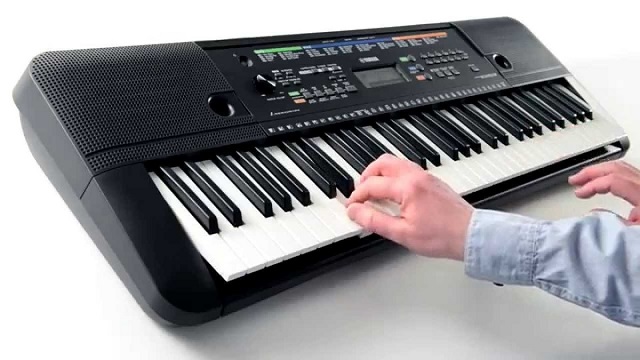 If you want, you can just let the PSR E253 play the songs as background music, but when you can also enter into one of three different lesson modes to learn the songs:
If you want, you can just let the PSR E253 play the songs as background music, but when you can also enter into one of three different lesson modes to learn the songs:
- Listen and Learn: You can play along to the song without any evaluation
- Timing: You play along with the song, but only timing is evaluated.
- Waiting: You play along with the song, but only correct notes are evaluated – the instrument waits for you to play the correct notes.
You can engage any of these modes with either left, right or both hands.
In addition to learning songs, Yamaha has also included a Chord Study mode that will show you how to play and voice a variety of chords. This can also be used in conjunction with the song library on the PSR E253.
Overall Impressions
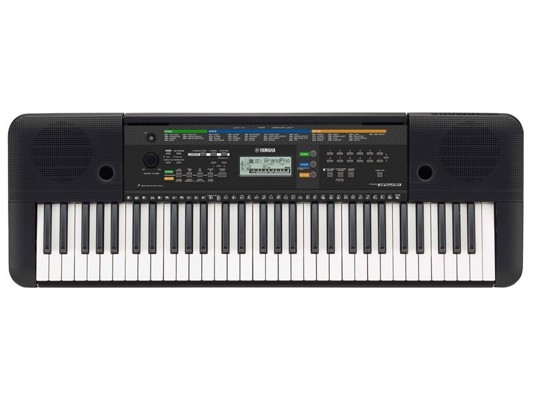 Looking at this instrument through the lense of a beginner or someone with limited keyboard skills, this is a portable keyboard that will keep you engaged for a while. The keyboard doesn’t have the feedback I’d look for, it lacks any MIDI or other interfacing capabilities, there are no pitch bend, modulation or other controllers installed… I could go on, but comparing this instrument to something you’d find a professional looking for is not fair at all. What it lacks in more studio-like features, it makes up for with tools to help your music knowledge grow … in a fun and engaging manner.
Looking at this instrument through the lense of a beginner or someone with limited keyboard skills, this is a portable keyboard that will keep you engaged for a while. The keyboard doesn’t have the feedback I’d look for, it lacks any MIDI or other interfacing capabilities, there are no pitch bend, modulation or other controllers installed… I could go on, but comparing this instrument to something you’d find a professional looking for is not fair at all. What it lacks in more studio-like features, it makes up for with tools to help your music knowledge grow … in a fun and engaging manner.
There are many more features that I don’t really have room to cover in this post. Yamaha has packed a lot into this instrument aimed at getting people to learn and enjoy playing music. If you have someone in your family who looks like they’re itching to let their inner muse out, then with the PSR E253 you’ve got a very cost effective start to realizing that dream.
The PSR E253 will be coming soon to Best Buy’s musical instrument department.




Love the The Air Hogs X-Wing Fighter
Comments are closed.